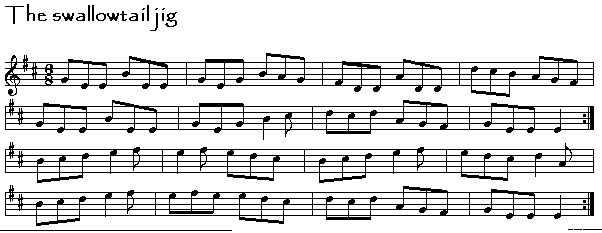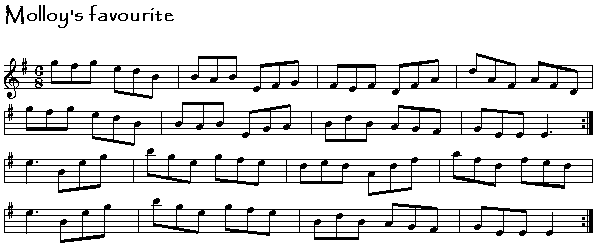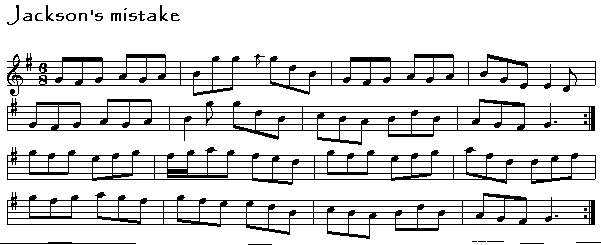Jigs II: some tunes to try
On this page, I'd like to explore jigs with different moods and characters.
But in all the examples on this page, I'll try to emphasise what I described on the previous page as a "lazy, rolling feel" that jigs need, even when you play them fast.
The swallowtail jig
I've chosen this tune because it seems to be a great favourite of beginner whistlers. This means that I often hear it played in a manner that I think you should steer clear of.

On the previous page about jigs I said I couldn't bring myself to demonstrate how not to play jigs. But on reflection I think it might be useful here.
|
|
Here is a clip of the first eight bars of this tune played in a common manner - don't imitate this (30K) |
As the girlfriend would say, "Beurk!" (Je dirais mÍme plus: "Beurk! Beurk! Beurk!") And as some wise and ironically diplomatic old musicians in Ireland would say, "Ah, yes, I've heard it played that way before."
So what's wrong with this rendition? Maybe you'll say it sounds bad because I tongued every note. True, I did. But in my opinion, it isn't the tonguing that makes it so unattractive. It's the rhythm that is wrong. The three-note groups are not shaped, they are just hammered out.
Let me try to prove my point.
|
|
Here's the same eight bars, with every note tongued, still no grace notes or anything, but with a different rhythm (34K) |
To me, that second clip actually sounds like a jig. It sounds lazy. It sounds like fun. It sounds as though someone might dance to it. Stretching that first note - rackety-tackety - makes all the difference. (I did play it a tad slower - but that's only partly responsible for the lazier feeling.)
Very few traditional players would play a jig with as much constant tonguing as in that example, and nor would I, normally. But I just wanted to make a point.
|
|
Here is how I might play the Swallowtail jig - if I couldn't avoid playing it, that is! (140K) |
I'd use my STT tonguing pattern (explained in the previous page on jigs), especially on the repeated Es and Ds in the first part, mixed up with more legato (slurred) passages. And a few cuts and graces. There's a cut in bar 6 of the second part to separate the two high Es. There's a tap on the quarter-note E in bar 2 of the second part (just to make a change from cuts). And there's a cut on the quarter-note D in bar 4 of the second part. Since I have my top finger lifter, cutting with the G finger gives an unusual-sounding cut, since the "note" produced is lower than the main note (it's somewhere between C-natural and C#).
Molloy's favourite
The next jig is a total contrast from The swallowtail jig. It was recorded as Molloy's favourite many years ago by the late Sean Ryan, a great fiddle player from Tipperary, and fluter P.J. Moloney. It is very similar to a better-known tune, Contentment is wealth, which was recorded not all that long ago by the group Patrick Street.
This tune lends itself to being played slowly, gracefully and lyrically, and would probably sound great on a low whistle.

|
|
Here's how I like to play this tune, keeping things fairly simple (175K) |
I put a few rolls in here and there. If you haven't mastered this ornament yet, don't worry, the jig will sound just fine without any rolls at all at all.
Jackson's mistake (The Munster jig)

This tune sounds great - well I think so, anyway - played fast. I love the rolling feeling in the second part of this tune, which just flows along.
|
|
Jackson's mistake (125K) |
A couple of small technical notes: in bar 2 of the first part, we have three repeated high Gs. I tongue the first and second (using the our good old STT tonguing pattern) and use a cut to articulate the 3rd one, thereby slurring "across the beat". A cut is also very important in bar 6 of the second part, where I used it to separate the two high Es without tonguing, thereby sustaining the tongue-free flow I'm trying to achieve in this phrase. I also try not to have to breathe in this phrase (bars 5-8 of the second part).
In bar 2 of the second part you'll notice that a couple of sixteenth notes. The high G has been added to fill in the interval between the F# and A - a little trick you'll find used very often.
What's next
What's next? Why, listening and practice of course. Listen to lots of jigs, played by good traditional players, and then learn them. By ear if you possibly can. Enjoy the different character of each jig. What kind of treatment suits the one you're learning now? Fast, slow? Lyrical, jumpy? Lots of tonguing, or hardly any? It's up to you...
I may add some more tunes to this page in time. But I think I need to plug a few other gaps in this site first.
Next page: Quick tips
Previous page: Jigs I
Updated 14 October 2004

